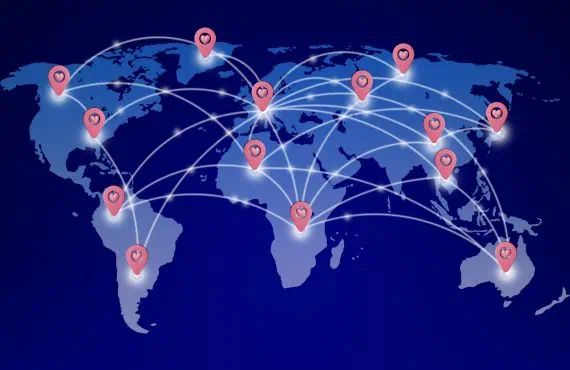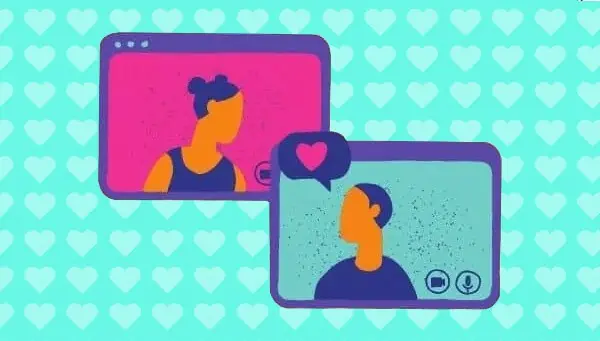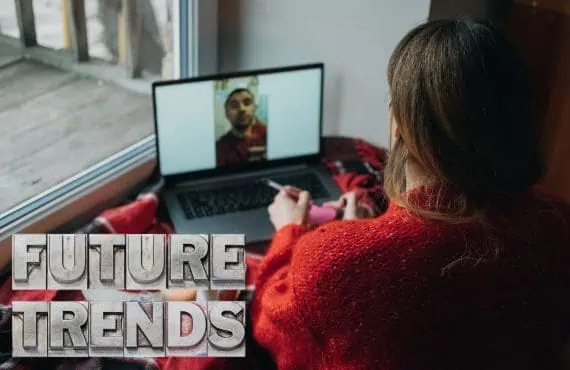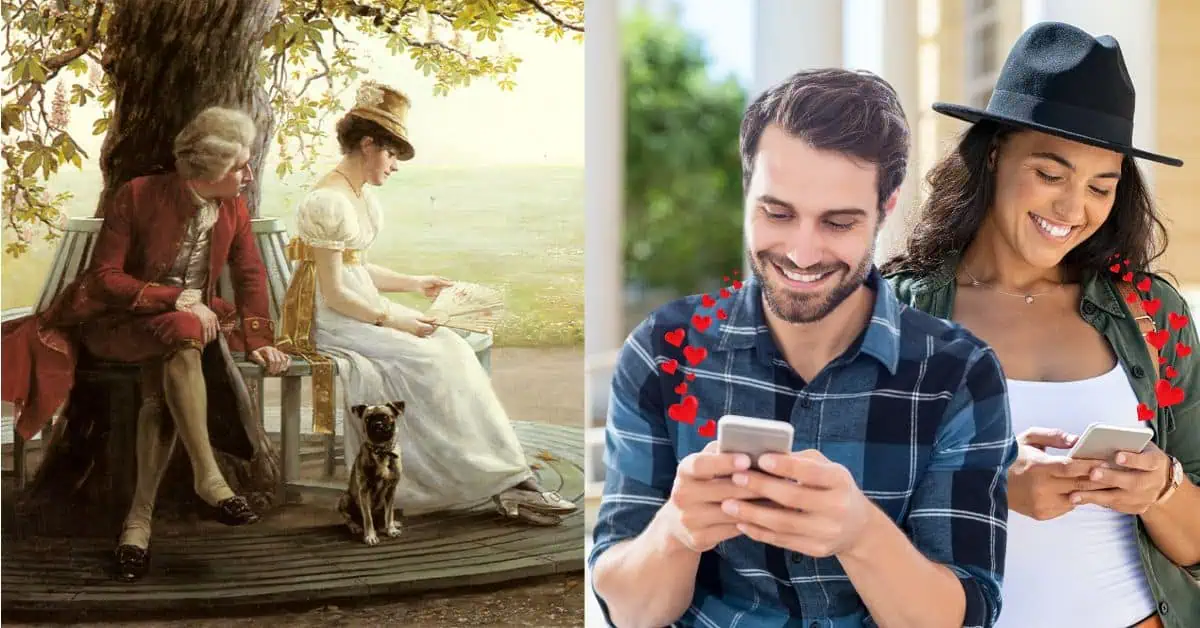In the late ’90s, meeting someone new usually meant running into them IRL, whether it was at a bar or a club, a house party, or through a friend. Fast forward to today, and the scenario is pretty different. You could be living in NYC and swiping right on someone on the West Coast, and a week later, you could be planning a trip to meet up. Dating dynamics have changed dramatically, and we can thank globalization for the way we connect romantically.
The changes in dating norms also play a part in our globalized world—they help us navigate and adapt to cultural differences and expectations that currently influence our love lives.
Come with us on a trip through the history of dating norms—we’ll also examine the latest trends and find out how globalization fits into it all and has impacted the way we form romantic relationships. From the evolution of courtship rituals to the rise of digital dating, we’ll uncover the forces at play in our constantly changing romantic landscape.
Historical Context of Dating Norms
To truly grasp the impact of globalization on dating, it’s essential to first look back at how romantic relationships were traditionally formed. Before the age of instant communication and cross-cultural exchanges, dating practices were heavily influenced by local customs and societal norms.
Traditional Dating Practices
Dating in the pre-globalization era was a formal affair with well-defined stages and societal expectations. Here’s a closer look at the key elements that characterized traditional dating practices:
Courtship Rituals
In many cultures, courtship was a ritualistic process where romantic interest was expressed through a series of structured and often elaborate steps. This could include formal introductions, chaperoned meetings, and symbolic gestures like gift-giving. For instance, in Victorian England, couples would exchange letters and tokens of affection under the watchful eyes of chaperones, ensuring propriety was maintained at all times.
Family Involvement
Family played a crucial role in the dating process–marriages were often arranged by parents or elders who believed they were best suited to find a compatible match for their children. This was especially prevalent in Asian and Middle Eastern cultures, where arranged marriages were the norm. The family’s approval was paramount, and the union was seen as the joining of two families rather than just two individuals.
Community Influence
The community also had a significant say in dating practices. Everyone knew each other in small towns and villages, and relationships were formed within a tight-knit social circle. Community events such as fairs, church gatherings, and dances allowed young people to meet and interact. These public settings allowed for social monitoring, ensuring that relationships adhered to the community’s moral and ethical standards.
Cultural Specificity
While the core elements of traditional dating were consistent, the specifics varied widely across cultures and regions. Each culture had its unique set of customs and expectations, reflecting its values and social structures.
- Europe: In Europe, courtship often involved a period of “wooing,” where the suitor would go to great lengths to prove his worthiness to the object of his affection. This might include serenading, writing poetry, or demonstrating bravery and skill. The focus was on romantic gestures and winning the approval of the woman’s family.
- Asia: In contrast, Asian cultures strongly emphasized familial duty and social harmony. Arranged marriages were common, with parents considering factors such as social status, family background, and astrological compatibility. Love was seen as something that could grow over time within the marriage rather than a prerequisite for it.
- Middle East: In the Middle East, dating practices were governed by strict religious and cultural norms. Courtship was closely monitored, and interactions between men and women were often limited to protect modesty and family honor. Marriages were typically arranged, and love matches were rare but not entirely unheard of.
- Africa: African cultures displayed a diverse range of dating practices. In some tribes, courtship involved elaborate rituals and ceremonies; in others, practical considerations such as the bride price or dowry exchange were more important. Community involvement and extended family played a significant role in the matchmaking process.
- The Americas: Indigenous cultures in the Americas also had distinct dating norms. For example, some Native American tribes practiced “bundling,” where a couple would spend the night together, fully clothed, in a bed with a wooden board between them to get to know each other better without physical intimacy. This allowed for a period of mutual discovery while maintaining societal boundaries.
Despite these cultural differences, a common thread ran through all traditional dating practices: the emphasis on family, community, and adherence to established norms. Relationships were not just personal unions but also social contracts that needed to be respected and upheld.
As societies began to modernize and globalization started to take hold, these traditional norms shifted. Increased mobility, urbanization, and exposure to different cultures brought new ideas and ways of thinking about relationships. The rise of individualism and personal choice started to challenge the collective approach to matchmaking, setting the stage for the evolution of dating norms we see today.
The Impact of Globalization on Dating
As the world becomes increasingly interconnected, the ways in which we form and maintain romantic relationships have undergone a profound transformation. Globalization, driven by advances in technology and the exchange of cultural ideas, has reshaped dating norms, making the landscape of love more diverse and dynamic than ever before.
Increased Connectivity
One of the most noticeable impacts of globalization on dating is the increased connectivity brought about by technology and the internet. This digital revolution has dramatically changed how we meet and interact with potential partners.
Rise of Online Dating Apps
The advent of online dating apps has revolutionized the dating scene, making it easier than ever to connect with people from all around the globe. Platforms like Tinder, Bumble, and OkCupid have millions of users worldwide, breaking down geographical barriers and allowing people to explore relationships beyond their immediate social circles. These apps use algorithms to match individuals based on their preferences, interests, and behaviors, creating opportunities for cross-cultural interactions that were previously unimaginable.

Online dating apps have also democratized the dating process. Unlike traditional dating practices, which often require family approval or adherence to societal norms, these platforms empower individuals to take control of their romantic lives. Users can choose who they want to interact with, setting their own criteria and preferences. This shift towards individual agency reflects a broader trend of personal choice and autonomy that is characteristic of the modern era.
Social Media’s Role in Forming Relationships
Social media platforms like Facebook, Instagram, and Twitter have also played a significant role in connecting people and shaping modern dating practices. These platforms allow individuals to present their curated versions, showcasing their interests, values, and lifestyles. This form of self-expression can attract like-minded individuals, facilitating connections that might not have occurred in the offline world.
Moreover, social media has made it easier to maintain long-distance relationships. Couples separated by vast distances can stay in touch through video calls, instant messaging, and shared social media activities. This constant connectivity helps to bridge the gap, making it possible for relationships to thrive despite physical separation.
Cultural Exchange
Globalization has also facilitated a rich exchange of cultural ideas and practices, profoundly influencing dating norms. Exposure to different cultures has led to adopting new practices and blending traditional and modern approaches to romance.
Adoption of New Practices
As people are exposed to different cultures through travel, media, and online interactions, they often adopt new dating practices that resonate with them. For example, the Western concept of casual dating and going on multiple dates before committing to a relationship has become more accepted in cultures that traditionally favored arranged marriages or formal courtship. This change shows a broader acceptance of diverse approaches to relationships and an openness to experimentation.
In addition, concepts like gender equality and individual rights, which are prominent in many Western societies, have influenced dating norms in other parts of the world. For instance, women in many cultures are now more likely to pursue their own romantic interests and assert their preferences, challenging traditional gender roles and expectations.
Blending of Traditional and Modern Approaches
While globalization has introduced new dating practices, it has also led to a blending of traditional and modern approaches. In many cultures, young people navigate a delicate balance between honoring their heritage and embracing contemporary dating norms. This blending creates a unique hybrid of practices that reflect both respect for tradition and a desire for personal freedom.
For instance, in some Asian cultures, the concept of “dating with intent” has gained popularity. This approach combines the Western idea of dating to find a compatible partner with the traditional emphasis on family approval and long-term commitment. Couples may date openly, but they also involve their families in the decision-making process, seeking their blessings before taking the relationship to the next level.
Similarly, the practice of arranged introductions has evolved in some cultures. Instead of arranged marriages, families may now arrange introductions or social gatherings where young people can meet potential partners in a more relaxed and informal setting. This modern twist on an old tradition allows for personal choice while still involving the family in the matchmaking process.

Challenges and Opportunities
While globalization has brought many positive changes to dating norms, it has also introduced new challenges. The increased connectivity and cultural exchange can sometimes lead to misunderstandings and conflicts as people navigate different expectations and values. For instance, cultural differences in communication styles, gender roles, and relationship dynamics can create friction in cross-cultural relationships.
Moreover, the abundance of options provided by online dating apps can lead to a phenomenon known as “choice overload.” With so many potential partners to choose from, people can struggle to make choices or commit to a single relationship. This can result in a cycle of perpetual searching and dissatisfaction as people constantly seek the “perfect” match.
Despite these challenges, globalization also offers opportunities for deeper connections and personal growth. Cross-cultural relationships can broaden individuals’ perspectives, fostering empathy, understanding, and appreciation for diversity. By navigating the complexities of globalized dating, people can develop stronger communication skills and a greater capacity for compromise and cooperation.
Current Trends in Globalized Dating
In today’s world, dating is vastly different from what it was even a decade ago, thanks to the powerful influence of globalization and technology. Here are some of the current trends shaping the landscape of globalized dating.
1- Online Dating Dominance
- Statistics on Online Dating Usage: The prevalence of online dating continues to grow rapidly. As of 2022, there were approximately 366 million users of online dating platforms worldwide. This number has significantly increased from 240.9 million in 2016. About 30% of adults in the United States alone have used an online dating site or app, with 19% currently using one. The appeal of these platforms lies in their convenience and ability to connect people from different locations and backgrounds.
- Popular Dating Apps Around the World: Tinder remains the most popular dating app globally, especially among younger adults. About 79% of online dating users under 30 have used Tinder, compared to 44% of users aged 30-49. Other widely used apps include Bumble, with its women-first approach, and eharmony, which is known for creating deeper connections. These apps, and others like Hinge and OkCupid cater to various demographics and dating preferences.
2- Cross-Cultural Relationships
Globalization has also facilitated an increase in intercultural relationships and marriages, bringing together individuals from diverse backgrounds.
Success Stories
One notable success story of an intercultural relationship is that of Sarthak and Julia. Sarthak, an Indian strategy director at Ogilvy, and Julia, a German managing director in Malaysia, met on a dating app during the pandemic lockdown. Their relationship blossomed despite the challenges, as they found common ground in their values and life goals. Both sets of parents were supportive, which played a crucial role in their successful union. They built strong bonds with each other’s families, using tools like Google Translate to overcome language barriers.
Another inspiring story is the “Magic Window” tale from the Peace Corps. A young Peace Corps volunteer in Morocco befriended an older Amazigh/Berber shopkeeper. Despite linguistic and cultural differences, they forged a deep friendship, using shared activities and cultural exchanges to build a strong connection. This relationship illustrates the power of genuine communication and mutual respect in bridging cultural divides.
Challenges Faced by Intercultural CouplesIntercultural couples often face unique challenges, including cultural misunderstandings, differing family expectations, and societal pressures. For instance, raising children can be complicated due to different cultural approaches to discipline, education, and family roles. Miscommunication is another significant issue, as partners may have different ways of expressing and dealing with emotions, leading to conflicts.
As seen in Sarthak and Julia’s story, navigating legal and bureaucratic hurdles is also a common challenge for international couples. They had to deal with extensive paperwork and legal formalities to get married, which was a time-consuming and stressful process. However, intercultural couples can overcome these obstacles by communicating effectively, respecting each other’s cultural backgrounds, and building fulfilling relationships.
3- Changing Gender Roles
- More Egalitarian Approaches: Globalization has led to more egalitarian approaches to relationships. Women increasingly take active roles in dating and relationships, challenging traditional gender norms. For example, apps like Bumble, where women make the first move, are gaining popularity. This shift reflects a broader trend toward gender equality and empowerment in romantic relationships.
- Shifts in Expectations and Responsibilities: As gender roles evolve, there is a noticeable shift in relationship dynamics. Traditional expectations are changing, such as men always paying for dates or making major decisions. Younger generations are more likely to embrace shared responsibilities and mutual respect. This shift promotes healthier, more balanced relationships where both partners contribute equally.
These evolving gender roles are also seen in intercultural relationships, where partners often have to navigate and negotiate their differing cultural expectations regarding gender. By fostering open communication and mutual respect, couples can create a harmonious and equitable partnership.
In summary, globalization has significantly influenced dating norms, leading to an increase in intercultural relationships and a shift towards more egalitarian gender roles. Despite the challenges, these trends offer opportunities for deeper connections and personal growth in romantic relationships.
The Role of Technology in Dating Evolution
The advent of technology has significantly transformed the dating landscape, making it more dynamic and accessible. From the convenience of mobile dating apps to the rise of virtual dating, technology continues to shape how people connect and maintain relationships.
Mobile Dating Apps
Mobile dating apps have completely changed how people meet and form romantic connections. The convenience and accessibility offered by these platforms are unparalleled.
- Convenience and Accessibility: Mobile dating apps like Tinder, Bumble, and Hinge have made meeting potential partners ao much easier. These apps allow users to create profiles and swipe through potential matches within minutes. The process is quick and user-friendly, eliminating the need for lengthy sign-up procedures. The sheer convenience of accessing these platforms anytime and anywhere has contributed to their widespread popularity. As of 2022, there were approximately 366 million online dating users worldwide, which continues to grow.
- Features like Geolocation and Matching Algorithms: One of the standout features of mobile dating apps is the use of geolocation technology. Apps like Tinder use GPS to show users potential matches within their vicinity, increasing the chances of meeting someone nearby. This feature is particularly useful for those looking to date locally or when traveling. Additionally, sophisticated matching algorithms have improved the quality of matches. These algorithms consider various factors such as interests, behaviors, and preferences to suggest compatible partners, enhancing the likelihood of successful connections.
Virtual Dates and Communication
The rise of virtual dating and long-distance communication tools has further expanded the possibilities for romantic connections.
Video Calls and Virtual Reality Dates
Technological advancements have made virtual dating a viable alternative to traditional in-person dating. Video calls on platforms like Zoom, Skype, and FaceTime allow couples to interact face-to-face, even when miles apart. This has been especially beneficial during the COVID-19 pandemic, as it provided a safe way for people to continue dating despite lockdowns and social distancing measures.

Virtual reality (VR) is also making its mark on the dating scene. VR dates offer an immersive experience, allowing couples to share virtual environments and activities, such as virtual walks on the beach or exploring a city together. These innovative approaches to dating help to create a sense of presence and intimacy, which can be challenging to achieve through text or phone calls alone.
Impact on Maintaining Relationships Across Distances
Technology has greatly facilitated the maintenance of long-distance relationships. Tools such as instant messaging, social media, and video calls enable couples to stay connected and engaged with each other’s lives. This constant communication helps to bridge the gap and maintain the emotional bond, making long-distance relationships more viable and less daunting.
Moreover, apps like WhatsApp and Telegram offer end-to-end encryption, ensuring privacy and security for couples communicating across distances. Social media platforms also keep relationships alive by allowing partners to share updates, photos, and experiences, fostering a sense of shared life despite the physical separation.
Socio-Cultural Impacts
The evolution of dating in a globalized world has led to notable socio-cultural impacts, influencing how individuals interact, form relationships, and perceive romantic connections. These impacts can be seen in the importance of cultural sensitivity and awareness, as well as the influence of global media and entertainment on dating norms.
Cultural Sensitivity and Awareness
In the context of global dating, cultural sensitivity and awareness are crucial. As people increasingly engage in intercultural relationships, understanding and respecting cultural differences become essential to fostering healthy and meaningful connections.
- Avoiding Stereotypes: Stereotyping in dating can lead to misunderstandings and conflict. For instance, assuming that all individuals from a particular culture behave in a specific way can create unrealistic expectations and strain relationships. It’s important to approach each person as an individual rather than as a representative of their culture. Educating oneself about different cultural practices and norms can help avoid these pitfalls. Research shows that cultural sensitivity can enhance communication and reduce the likelihood of conflict in intercultural relationships.
- Appreciating Cultural Differences: Appreciating cultural differences involves recognizing and valuing each culture’s unique aspects to a relationship. This appreciation can enrich the relationship by introducing new perspectives and traditions. For example, celebrating each other’s cultural festivals, understanding different communication styles, and respecting various social norms can strengthen the bond between partners. Studies have shown that couples who actively engage with and appreciate each other’s cultural backgrounds report higher relationship satisfaction.
Influence of Media
Global media and entertainment have a profound impact on shaping dating norms and expectations. Movies, TV shows, music, and other forms of popular culture significantly influence how people perceive and engage in romantic relationships.
Movies, TV Shows, and Music
Media representations of romance often set standards and expectations for relationships. Romantic comedies, dramas, and even music lyrics can shape people’s ideas about love, courtship, and relationship dynamics. For example, Hollywood films often portray grand romantic gestures and idealized love stories, which can influence viewers’ expectations of their own relationships. Examples of such movies include The Notebook, which depicts a passionate and enduring love story, and Crazy Rich Asians, which blends romantic comedy with cultural exploration. TV shows like Friends and How I Met Your Mother also play a role by showcasing various dating scenarios and relationship dynamics that resonate with audiences.
Media also plays a role in normalizing certain dating practices. For instance, the portrayal of online dating in TV shows and movies has helped reduce the stigma associated with meeting partners online, making it a more accepted and mainstream way to find love. Additionally, media can introduce audiences to different cultural perspectives on dating, promoting greater understanding and acceptance of diverse romantic practices.
Popular Culture and Its Effect on Dating Expectations
Popular culture significantly impacts dating expectations by setting trends and norms that people often feel pressured to follow. Social media influencers and celebrities frequently showcase their romantic lives, setting aspirational standards for their followers. This can create pressure to emulate these lifestyles, sometimes leading to unrealistic expectations and dissatisfaction in one’s own relationships.
Furthermore, the global reach of popular culture means that dating norms from one part of the world can influence practices elsewhere. For instance, the Western concept of casual dating has gained popularity in many non-Western cultures, where traditional courtship practices were once more prevalent. This cultural exchange can blend dating practices, creating new norms that reflect a mix of traditional and modern approaches.
Challenges in a Globalized Dating World
In today’s interconnected world, dating has become more complex, presenting unique challenges for individuals. Understanding cultural differences and addressing privacy and security concerns are two primary issues in globalized dating.
Cultural Differences
Intercultural relationships can be enriching, offering opportunities to learn and grow. However, they also come with specific challenges that require careful consideration.
- Communication Barriers: One of the main hurdles in intercultural relationships is communication. Language differences can lead to misunderstandings and misinterpretations. Even when partners speak the same language, cultural nuances can affect communication. For instance, in some cultures, direct communication is valued, while in others, indirect communication is the norm. These differences can lead to frustration and conflict if not addressed. Research shows that couples who develop effective communication strategies, such as learning each other’s languages and being patient with misunderstandings, are more likely to overcome these barriers.
- Differing Family Expectations: Family expectations can vary widely between cultures, creating potential conflicts in intercultural relationships. In many cultures, family approval and involvement in the relationship are crucial. For example, traditional Asian and Middle Eastern cultures often place a high value on family consent for marriages, while Western cultures may prioritize individual choice. These differing expectations can lead to stress and tension between partners and their families. Understanding and respecting each other’s family dynamics and finding a balance between cultural expectations and personal preferences are essential for managing these challenges.
Privacy and Security
As online dating becomes more popular globally, concerns about privacy and security are growing.
- Data Privacy: The vast amount of personal information shared on dating apps raises concerns about data privacy. Users often provide sensitive details such as their location, interests, and personal preferences. This information, if not adequately protected, can be misused by malicious actors. Data breaches in the past have exposed user information, leading to potential identity theft and other cybercrimes. Dating apps must implement robust security measures, such as encryption and regular security audits, to protect user data. Users should also be cautious about the information they share and regularly update their privacy settings to limit exposure.
- Risks of Catfishing and Scams: Catfishing, where individuals create fake profiles to deceive others, is a prevalent issue in online dating. Scammers often use these fake identities to manipulate and exploit unsuspecting users emotionally and financially. The global nature of online dating means that these scams can cross international borders, making it challenging to track and address them. Educating users about common signs of catfishing, such as inconsistent information and requests for money, can help mitigate these risks. Additionally, dating platforms should invest in advanced verification processes to authenticate user profiles and reduce the likelihood of scams.
The challenges of globalized dating are multifaceted, involving both cultural and security aspects. Understanding cultural differences requires good communication and a mutual understanding of family expectations.
Future Trends in Global Dating Norms
As dating continues to evolve, there are a few telling trends that are expected to alter the landscape of romance. These trends include a move towards more personalized dating experiences and a growing emphasis on sustainability and ethical considerations.
More Personalization
Dating apps are set to become even more personalized, leveraging advanced technologies to improve user experiences.

- Better Matching Algorithms: The future of dating apps lies in the refinement of matching algorithms. With advancements in artificial intelligence and machine learning, these algorithms will become more adept at understanding users’ preferences and behaviors. Apps will use this data to suggest highly compatible matches, leading to more meaningful connections. This focus on personalization will help users find partners who align closely with their values, interests, and lifestyle choices.
- Personalized Dating Experiences: Beyond matching algorithms, dating apps will offer more tailored experiences. Features like geolocation will continue to play a crucial role, allowing users to connect with potential partners nearby or in specific locations they frequent. Additionally, apps will likely introduce more niche features catering to specific interests and communities, such as eco-conscious dating options or platforms focused on social causes. These personalized experiences aim to enhance user satisfaction and engagement.
Sustainability and Ethical Considerations
The increasing awareness of environmental and ethical issues influences dating behaviors and practices as well!
- Eco-friendly Dating Options: As environmental consciousness rises, more people are seeking eco-friendly dating options. This trend includes choosing dates that minimize environmental impact, such as outdoor activities, dining at sustainable restaurants, or participating in community service projects together. Additionally, some dating apps are incorporating sustainability into their platforms by highlighting users’ environmental values and promoting green initiatives.
- Ethical Considerations in Choosing Dating Platforms: Ethical considerations are becoming increasingly important in the choice of dating platforms. Users are now more aware of data privacy and security issues and are likely to prefer platforms that prioritize these aspects. Transparency about data usage and robust security measures will be crucial for dating apps to build and maintain trust with their users. Moreover, there is a growing demand for platforms that actively combat issues like harassment, catfishing, and scams, ensuring a safer and more respectful dating environment.
The future of global dating norms is characterized by greater personalization and a focus on sustainability and ethics. As technology continues to advance, dating apps will offer more tailored and meaningful experiences, helping users find partners who align with their values and lifestyles. At the same time, the increasing emphasis on environmental and ethical considerations will shape how people approach dating, from choosing eco-friendly activities to selecting secure and responsible platforms. These trends reflect a broader shift towards more conscious and intentional dating practices, paving the way for healthier and more fulfilling relationships.
Conclusion
Dating norms have come a long way from the olden days (thank goodness), and globalization has had a hand in these changes!
Recognizing cultural diversity and keeping an open mind in the global dating scene leads to much more meaningful and fulfilling romantic relationships! Appreciating different cultural perspectives improves our romantic experiences and helps us build real connections.
Being open-minded allows us to move beyond stereotypes and see each person as an individual, thereby reducing conflicts and opening doors to happy and healthy relationships. Ethical dating practices also play a big part in a safer, more inclusive environment for all.
So, let’s celebrate what makes us different and create a more respectful global dating scene that is full of opportunities for genuine connections.
